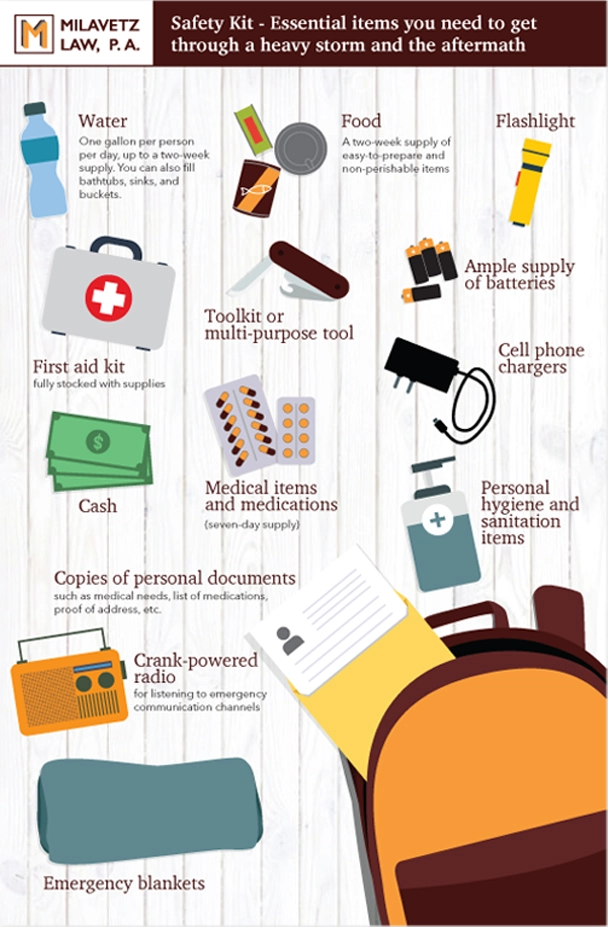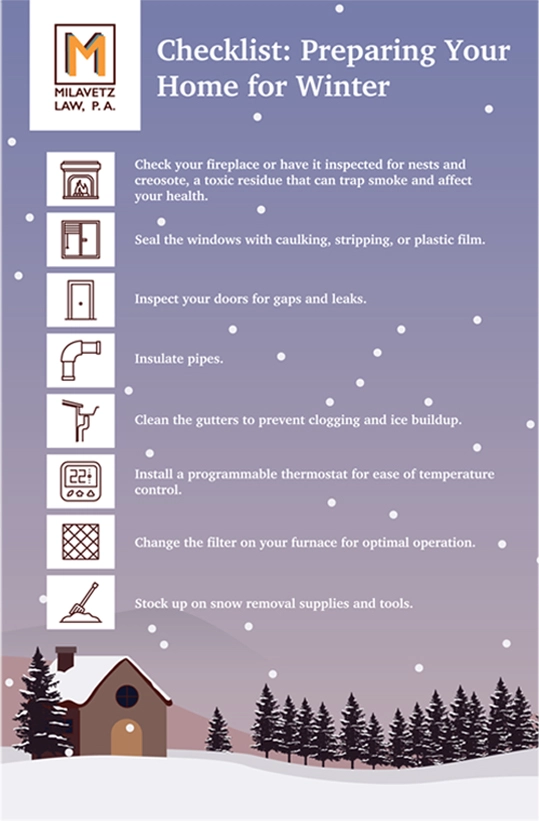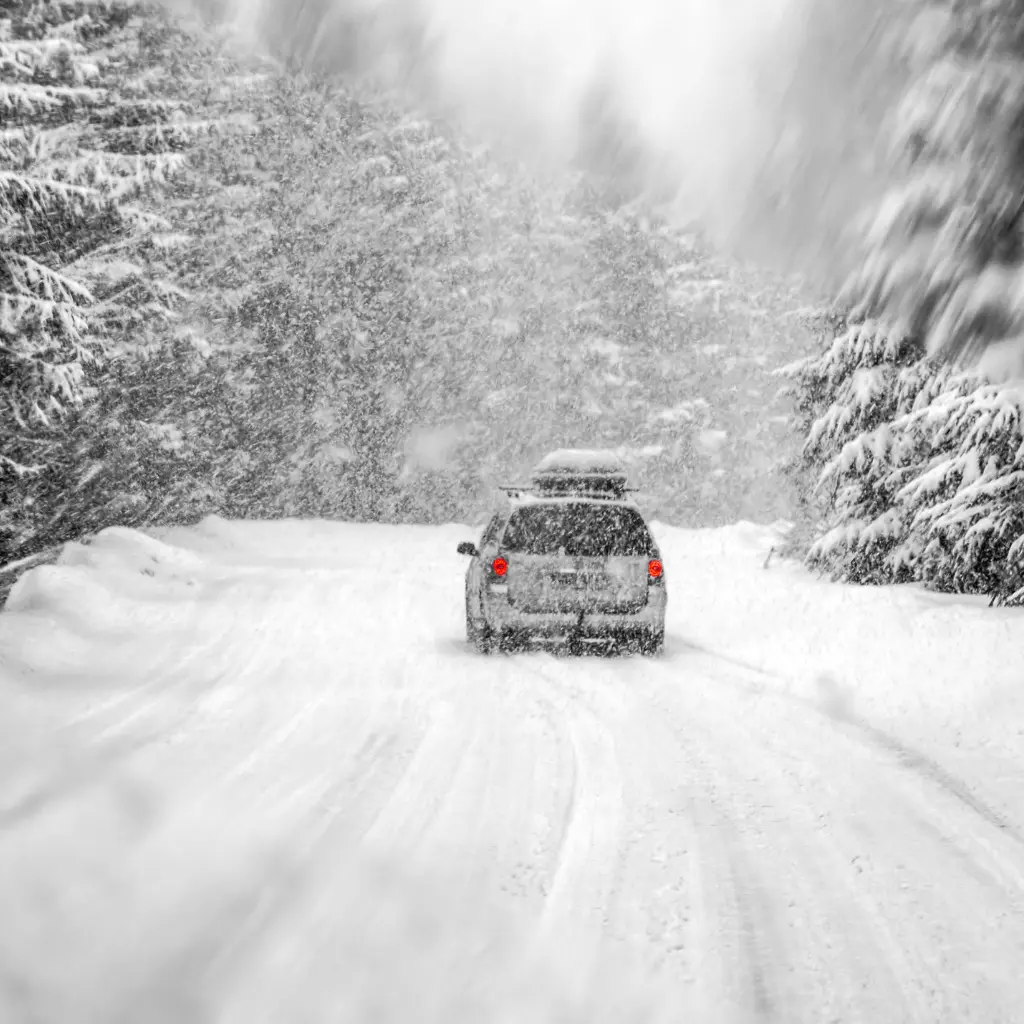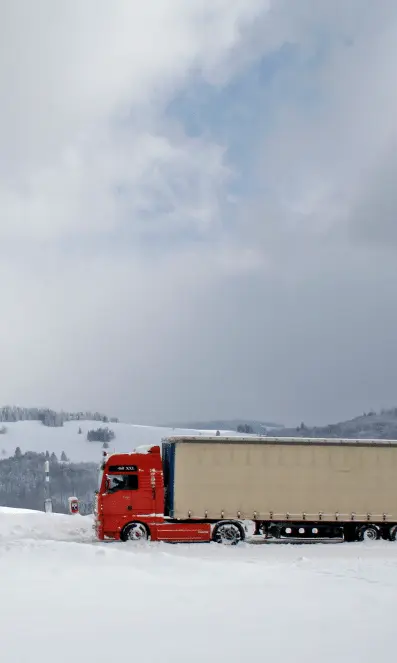Winter Storm Safety:
What You Need to Know
to Stay Safe and Warm
Winter storms arise when the temperature is at or below 32 degrees, and strong, gusting winds are present to draw moisture from bodies of water to create clouds. As the moisture returns to the ground, the cold temperature it encounters on the way down forms freezing rain, sleet, and snow.
Ice storms are more likely when temperatures are closer to freezing, and a blizzard is more likely when the temperatures are well below freezing. Both types of precipitation create dangerous conditions that require you to be more vigilant than usual and engage in safety practices for all situations.
Whether with ice or heavy snow, winter storms cause low visibility, slick roads, and blinding glare from reflected light. The ambient temperature of asphalt and concrete roadways reflects that of the air and allows ice and snow to build up. Ice freezes on the roadway, sometimes resulting in black ice that’s almost invisible to the eye and can cause you to spin out unexpectedly and collide with another vehicle.
Snow builds up on the roads and makes it difficult for you to see where the lanes and shoulders are located. It also packs down, creating ice buried under the snow, and ruts are formed as cars pass over the drifts. Last but not least, blowing snow and ice lowers visibility conditions for everyone, which makes travel and outdoor activities dangerous.
How to
Prepare
The time to prepare for a winter storm is long before the weather arrives and when the supplies are available online or in the stores. There is no such thing as being over-prepared for a blizzard or ice storm, as you never know how long the storm will last. A heavy storm can cause utilities to go down, and there’s no predicting how long it will take for them to come back on.
With some preparation, you can be ready for winter storms.

Safety Kit
Safety Kit A safety or survival kit contains essential items you need to get through a heavy storm and the aftermath that may involve a power outage and extreme cold. You can prepare some items when you hear an advance warning about a blizzard. You’ll want to have other supplies on hand long before there’s a storm to avoid trying to find them at the last minute.
According to the American Red Cross, your safety kit should contain items that include:
- Water: One gallon per person per day, up to a two-week supply. You can also fill bathtubs, sinks, and buckets.
- Food: A two-week supply of easy-to-prepare and non-perishable items
- Flashlights
- First aid kit fully stocked with supplies
- Toolkit or multi-purpose tool
- Ample supply of batteries
- Emergency blankets
- Cell phone chargers
- Medical items and medications (seven-day supply)
- Crank-powered radio for listening to emergency communication channels
- Copies of personal documents such as medical needs, list of medications, proof of address, etc.
- Cash
- Personal hygiene and sanitation items
Winterize Your Home
Fall is the best time to winterize your home and be ready for the worst of the winter storms. The weather is still warm enough to do outside work and inspect the home’s exterior to find gaps that need to be closed up.
Checklist: Preparing Your Home for Winter
- Check your fireplace or have it inspected for nests and creosote, a toxic residue that can trap smoke and affect your health.
- Seal the windows with caulking, stripping, or plastic film.
- Inspect your doors for gaps and leaks.
- Insulate pipes.
- Clean the gutters to prevent clogging and ice buildup.
- Install a programmable thermostat for ease of temperature control.
- Change the filter on your furnace for optimal operation.
- Stock up on snow removal supplies and tools

Prepare Your Car
Your car must be able to withstand the rigors of winter weather for it to be reliable. Schedule an appointment with your mechanic to have them inspect your car’s major systems to ensure that they’re in proper working order.
Check the tread on your tires for wear. An easy test to check the tread is to stick a penny with Lincoln’s head pointing toward the tire. If you can see all of Lincoln’s head, your tires need replacing.
Check your windshield wipers, and replace them if it’s been a while since you’ve installed the current set.
Last but not least, always keep your gas tank full during the winter to prevent freezing in the fuel lines that can prevent your car from turning over.
Prepare Your Small Business
Businesses must also be prepared for a severe weather event to make it through a prolonged closure and easily recover when the normal course of business can resume.
Tips for Preparing Your Business for a Snowstorm
- Create a plan of communication with employees to let them know what’s expected of them during a snowstorm.
- Let customers know if you’re closing through all possible channels, including social media.
- Stock up on bags of salt for clearing ice from sidewalks.
- Keep shovels on hand and make sure they’re easily found.
- Check the smoke and carbon monoxide detectors to make sure they’re working.
- Consider buying a generator to prevent the loss of perishable goods.
- Have a backup plan for taking care of business paperwork and payroll if mail delivery gets delayed.
- Report any downed power lines and keep staff and customers away from them.
You may not be able to reach your small business during the storm, but you still need to keep your premises free and clear from hazardous conditions in a reasonable timeframe. One option is to contract with a snow removal company that comes and clears snow from the sidewalks and parking lots and lays down salt to eliminate patches of ice.
During & AfterThe Storm
The safest place to be during a heavy snowstorm is inside your home. Your home’s structure protects you from snow and ice, and the roof is designed to bear the load of the snow. Don’t go outside unless you have to, and wait for the snowstorm to pass before starting the cleanup efforts. The Centers for Disease Control and Prevention offer tips for staying safe in your home during a winter storm.
How to Stay Safe Inside
As you wait out the storm, you want to be comfortable, but do not strain your resources because it may be difficult to replenish your supply. Watch the weather forecast to anticipate how long the storm will last so you can make your supplies last.
If you have a generator for power outages, make sure that you have it set up in a location that’s easy to reach from the house but not so close that exhaust can permeate the inside of your home and cause carbon monoxide poisoning. The same goes for any fuel-powered heaters used in the home that need ventilation.
Conserve heat by closing doors to rooms that aren’t in use and closing the vents to redirect heat to other rooms. Use draft blockers or towels under the doors to block cracks through which heat may escape.
Have blankets handy, and ensure that pets have ample bedding so they can also stay warm. Minimize trips outside as much as possible to reduce the potential for heat loss.
Cleaning Up
When the snow stops falling, it’s time to clean up the debris and assess the damage. Insurance companies, such as Chubb and Metlife, advise that homeowners walk around their homes — inside and out — after the snow has stopped falling to look for structural damage caused by the storm.
Here’s what you should look for as you survey your home for damage:
- Check windows for cracks and air leaks.
- Make sure your water pipes aren’t frozen and turn off the water to pipes that have frozen.
- Look at chimneys for any damage to prevent smoke from backing up inside the house.
- Make sure the smoke and carbon monoxide detectors are working properly, especially if you have a fireplace.
- Inspect the ceilings for cracks or leaks that may indicate an ice dam (build-up of ice on the eaves).
- Look for downed power lines.
- View the roof to determine how much snow is resting on top of it and prepare to clear it off if snow is abundant.
Safety is important as you work to clear out the snow after the storm has passed. Shoveling heavy snow can increase the risk of a heart attack and cause back injuries. Avoid the risk of injury and use a snow shovel with an ergonomic handle, or use a snow scoop that pushes snow out of the way without the need for lifting. The best option for preventing physical injury is using a snowblower and letting it do the hard work.
- Tools for Shoveling Snow After a Storm
- Ergonomic snow shovel
- Snow scoop with wheels
- Roof rake to pull snow off the roof and prevent ice dams
- Electric snowblower
- Gas-powered snowblower for sidewalks and small driveways
- Garden tractor with snow plow attachment if feasible
Hypothermia & Frostbite
Being outside in extreme cold and snow can put you at risk of hypothermia and frostbite. According to the Mayo Clinic, hypothermia is a medical emergency in which your body’s core temperature drops below 95° F. Frostbite occurs when the skin is exposed to cold temperatures for an extended period of time.
The signs of hypothermia include:
- Shivering
- Memory loss
- Slurred speech
- Tiredness
- Shallow breathing
- Weak pulse
- Loss of hand control and coordination
- Confusion
If you’re with someone who exhibits signs of hypothermia, call 911 immediately. Avoid jarring movements that may affect the person’s heartbeat and gently move them indoors, covering them with warm, dry blankets.
Signs of frostbite include:
- Cold skin
- Sensation of needles and pins
- Numbness
- Pale or discolored skin
- Hard texture to the skin
- Blistering
Mayo Clinic warns that all cases of frostbite require medical attention, as it can cause permanent damage to skin and other tissue.
Driving in
Winter Weather
Driving in a winter storm is dangerous. The AAA Foundation for Traffic Safety warns that “winter storms, bad weather and sloppy road conditions are a factor in nearly half a million crashes and more than 2,000 road deaths every winter.”
It’s imperative that drivers have the skills for driving during a winter storm and what to do in an emergency.
Car Maintenance
When you park your car outside during snowy weather, it will accumulate a layer of snow. The longer the storm, the higher the snow, and the more important it is to clear as much of it off as possible. Snow on a car’s hood may blow onto the windshield and obscure the driver’s vision, whereas snow on a car’s roof can blow onto the car behind it, hindering the other driver’s view of the road.
You’ll need tools to help you clean the snow off your car. That includes brushes, ice scrapers, and foam snow brooms that help you remove the snow, scrape off the ice, and spend less time and effort clearing snow and ice off your car. A foam snow broom is made from a stiff piece of foam that has enough rigidity to push snow off your car in one movement. They’re worth putting into your snow removal toolkit because they’re effective, won’t scratch paint, and remove a lot of snow in the least amount of time. The brush and scraper are handy for removing the last layers of snow and clearing the ice from your windows.
Keep a bottle of de-icer in your home and bring it with you when you go to your car to melt ice and gain access if the doors have frozen shut. Make sure to use a de-icer to clear the windshield instead of using your windshield wipers and defroster. Ice on the windshield can ruin your wipers.

Black ice creates difficult and dangerous driving conditions due to its lack of visibility in certain light conditions. You may not know that you’re driving on black ice until you suddenly lose control of your car. When you feel your car sliding and going in a direction you don’t intend it to go, don’t panic. Instead, take these actions to help you regain control of the wheel again:
- Don’t brake.
- Take your foot off the gas.
- Steer in the direction you want the car to go.
- Let the car slow down until the wheels are contacting the road again and allow you to regain control.
What to Do if You Get Stuck
Another issue drivers face is when vehicles get stuck in the snow because the wheels generate little to no traction. Snow compacts and turns into ice as you try to break the wheels loose, making it difficult to get the car unstuck.
The tried-and-true method of getting a car unstuck is to rock it out of the bank. Rocking the car consists of keeping the front wheels turned in the direction you need to go, then driving the car forward. Once you can’t go any further, put the car in reverse and go as far back as possible. Repeat this action until the car comes free of the snow. Rocking a car free from snow can take time and effort, and this is where keeping tools in your car comes in handy.
Emergency Tools and Supplies
A set of portable tire traction mats, also known as a portable tow truck, and a trunk-sized shovel are easily stowed in your car’s trunk or cargo area. Both are ideal tools for getting your car unstuck. You can shovel out the snow from in front of the wheels to get the car to contact the asphalt and gain traction. Tire traction mats are placed in front of your car’s tires, enabling your car to gain traction in the snow as you drive forward. Make sure to go slow over tire traction mats for them to be effective.
Prepare an emergency kit for your car with items similar to those you keep in the home for the same purposes. Also, keep a blanket or two in the car in case you’re stuck in a snowbank and you won’t be able to get assistance for a while. You can turn on the engine for brief periods to warm up, but you don’t want to run the risk of carbon monoxide poisoning from a blocked tailpipe. It’s also a good idea to preserve the gasoline in your tank for when the rescue vehicle arrives, and you need to use the car to help you get unstuck.
Truckers & Icy Roads
Truckers have to deal with a trailer that can fishtail in high winds and the potential for jackknifing when encountering poor road conditions. Truck drivers should pull off the road as soon as possible when weather conditions cause poor visibility.
If there is no safe place to pull over, practice safe driving techniques that include:
- Maintaining a safe distance between other vehicles
- Staying out of packs on the highways
- Checking the tires on the truck and trailer for inflation and tread levels
- Carrying tire chains for use in states where they’re legal or required
- Avoiding braking on icy roads
- Carrying an emergency kit designed for semi-trucks
Preparing for hazardous weather conditions is an important part of a truck driver’s job. The website truckstop.com suggests consulting the National Weather Service for the weather forecast and the U.S. Department of Transportation to anticipate road closures and heavy traffic areas.

Premises Liability &
Winter Storms
Businesses should be especially vigilant to prevent hazardous conditions, such as water puddling inside the doorways and ice on the sidewalks. If a personal injury is due to these conditions, it could lead to a slip-and-fall injury lawsuit because the business didn’t act in a timely manner to make the area safe.
Homeowners, too, must be aware of these hazards and make sure they’re cleaned up. A visitor to the home can have a slip and fall, injure themselves, and sue the homeowner for the injury.
Although businesses and homeowners typically carry insurance to protect themselves financially from a premises liability case, they are still liable for the injuries someone sustained because they failed to take action and eliminate the hazard once they were aware of it. Protect your visitors, customers, and yourself by repairing all damages caused by inclement weather and warning of any potential dangers during post-storm cleanup and maintenance.

